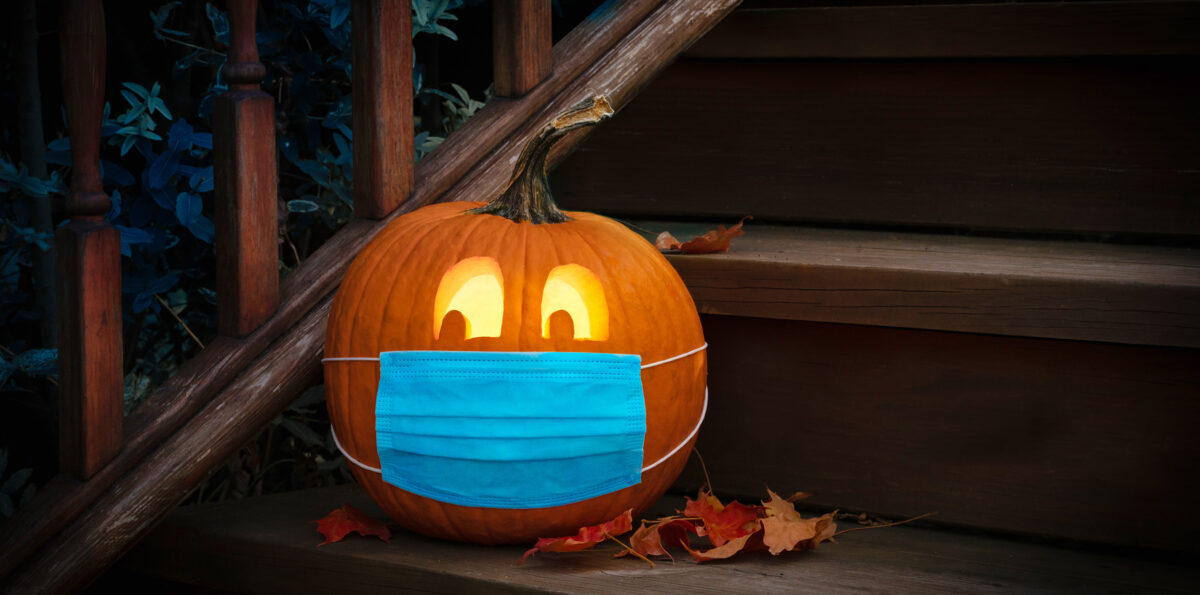Halloween safety 101: How to celebrate safely in the time of COVID-19

Though COVID-19 still lurks among us, some aspects of Halloween are making a comeback. In a CNN interview, Dr. Anthony Fauci, the U.S.’s top infectious disease expert, endorsed outdoor trick-or-treating this year. With a little caution and imagination, revelers can engage in plenty of spooky, holiday fun.
Trick-or-treat with care
While Dr. Fauci and other public health experts, such as Dr. Rochelle Walensky, director of the Centers for Disease Control and Prevention (CDC), have given the greenlight for outdoor trick-or-treating, that doesn’t mean the activity is risk-free from exposure to COVID-19. A majority of children who will be going door-to-door this year are under 12 and have yet to be vaccinated, so it’s important to take the following precautions.
Wear a facial covering
A cloth mask or a disposable surgical-style mask that snugly covers the nose and mouth should be worn at all times. A commercial costume mask will not provide the same level of protection. Don’t put a costume mask over the cloth or disposable mask. Adults traveling with kids should wear masks, too.
Maintain distance at the door, avoid crowds. When your child approaches a house, have them ring the doorbell and place their bag close enough to the door for the homeowner to put the treat in the bag while your child stands six feet away. They should not retrieve the bag until the homeowner has closed the door. If there is already a group at a house, wait until they have left before approaching. Avoid congregating in large groups on sidewalks.
Bring hand sanitizer
Sanitize your child’s hands frequently.
Save the candy for home
Wait until you’ve gotten home and your children can wash their hands thoroughly before letting them eat any of the candy. (The risk of the wrapped candy itself spreading COVID-19 is pretty low, as long as you use good hand hygiene.) Learn more about how much to let kids indulge in their cache of Halloween candy.
Reserve the party for the patio, get creative
Some typical Halloween events, such as parties held indoors, can put kids and family members at a higher risk of exposure to COVID-19.
“In general, as with any activity, the risk for getting infected is related to time, space, number and distance,” said Mary Fairchok, MD, pediatric infectious disease specialist with Mary Bridge Children’s Hospital & Health Network. “More than 15 minutes in close contact; indoors in a small space that is not well ventilated; more than five people; less than six feet apart. These are all factors that increase risks. I would not recommend a Halloween party unless it is outdoors and attendees are masked.”
Dr. Fairchok and Michael Myint, MD, an infectious disease specialist and epidemiologist with MultiCare — as well as numerous health experts and public health agencies — recommend against many standard Halloween activities held indoors this year, to help reduce the spread of COVID-19.
Even if trick-or-treating is not on your agenda and you don’t want to hold a party in your backyard, that doesn’t mean Halloween must be cancelled. Coming up with ways to celebrate the holiday may be even more important given the number of event cancellations, routine changes and general lack of social activities over the last 18 months.
If you’re looking to set new traditions, some alternative ways to celebrate Halloween include:
- Organizing families in your community for an outdoor Halloween parade in costumes through the neighborhood
- Carving or decorating pumpkins outside, physically distanced, with neighbors or friends
- Doing a Halloween scavenger hunt where children are given lists of Halloween-themed things to look for while they walk outdoors from house to house
- Having a virtual Halloween costume contest
- Exchanging candy with families you know — drop off Halloween surprises on one other’s doorsteps
- Trick-or-treat inside your home by hiding candy for your kids to find
For more information about how to gather safely, visit the CDC. Wondering how much candy is too much? Read more from Mary Bridge Children’s registered dietitians.